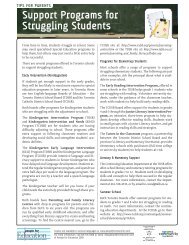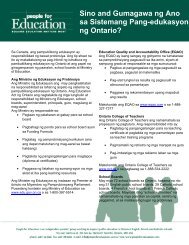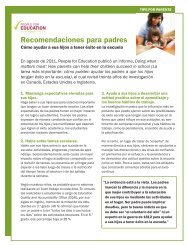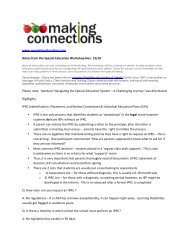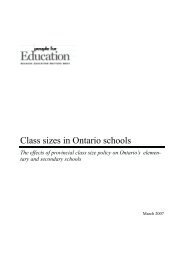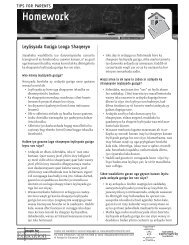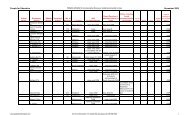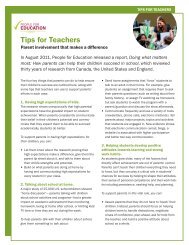Our Children Our Future Our Vision - People for Education
Our Children Our Future Our Vision - People for Education
Our Children Our Future Our Vision - People for Education
Create successful ePaper yourself
Turn your PDF publications into a flip-book with our unique Google optimized e-Paper software.
<strong>Our</strong> <strong>Children</strong>, <strong>Our</strong> <strong>Future</strong>, <strong>Our</strong> <strong>Vision</strong><br />
Canada must act immediately to meet with First Nations and develop an emergency plan to<br />
address the crisis of poverty and lack of adequate education services in First Nations which would<br />
include devising a funding <strong>for</strong>mula based on need – not on “value <strong>for</strong> money” and certainly not at<br />
levels lower than other Canadians.<br />
(b) Endless Studies and Reports<br />
“Make sure something is done this time to improve education with<br />
this study. There’s been too many of them – it seems we’ve been going<br />
in circles.” (Grandparent)<br />
Just like the shameful socio-economic statistics, the issues in First Nation education are not new,<br />
nor is there any lack of study, research, insight, or analysis about these issues. There are numerous<br />
reports that, to varying degrees of specificity, highlight the core challenges and the solutions to<br />
bring about improvements. Some of these reports have even highlighted success stories and the<br />
background work that was done to ensure success. There is very little, if anything, that this report,<br />
or any other “new” panel, study or report could say to add to the well-known challenges and steps<br />
required to make substantive changes towards success <strong>for</strong> our children, families, communities and<br />
Nations.<br />
What follows is a brief overview of some of the more major reports, studies and publications on<br />
First Nation education challenges and solutions.<br />
Indian Control of Indian <strong>Education</strong> – 1972<br />
In 1969 the Liberal government introduced the White Paper which would have abolished the Indian<br />
Act, Indians, treaties and land claims. 96 The response from First Nations was swift, united and unequivocal<br />
– the White Paper and its goal of stripping First Nations of their rights and identities were<br />
wholly rejected. 97 The written response penned by Harold Cardinal and now referred to as the Red<br />
Paper, highlighted the fact that Canada could not unilaterally decide to default on all of its<br />
obligations to First Nations including treaties. 98<br />
Shortly thereafter, the National Indian Brotherhood (now AFN) issued a policy document called<br />
Indian Control of Indian <strong>Education</strong>. 99 It emphasized several key policy directions to improve First<br />
Nation education. First was that Canada had a responsibility under at least 11 major treaties to<br />
provide funds <strong>for</strong> education. It also focused on the need <strong>for</strong> First Nation education to incorporate<br />
96 Government of Canada, “Statement of the Government of Canada on Indian Policy presented to the First Session<br />
of the Twenty-eighth Parliament by the Honourable Jean Chretien, Minister of Indian Affairs and Northern Development”<br />
(Ottawa: Department of Indian Affairs and Northern Development, 1969) [White Paper].<br />
97 RCAP, supra note 6.<br />
98 H. Cardinal, The Unjust Society: The Tragedy of Canada’s Indians (Cali<strong>for</strong>nia: M.G. Hurtig, 1969) (reprint) [Red Paper].<br />
99 National Indian Brotherhood, “Indian Control of Indian <strong>Education</strong>” (Ottawa: NIB, 1972) [Indian Control].<br />
Chiefs of Ontario<br />
20



